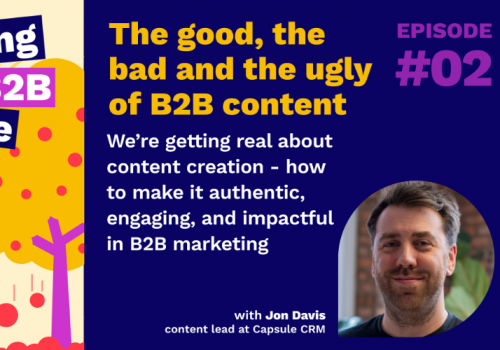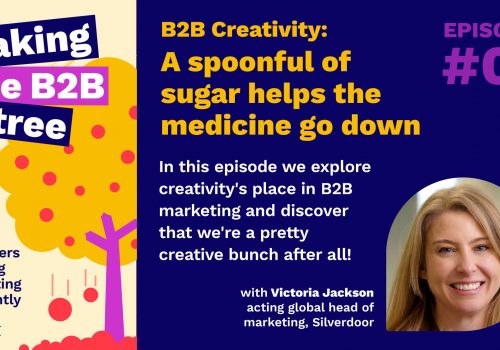Interview with Sue Westhead
Among her many talents, Sue Westhead is a serial Skout client. We’ve been her B2B PR agency in three separate roles over the past 10 years. One of the reasons we love working with Sue is that, like us, she’s a great integrated thinker when it comes to B2B PR and marketing. That’s why we asked her to tell us why B2B marketing integration is so crucial to success. Here’s what she said!
What is B2B marketing integration to you?
For me, it’s about getting the very best value from all marketing activities. An integrated approach gives you the opportunity to connect with your audience across many channels, and through different phases of the customer journey, whilst always remaining in-keeping with your brand promise.
It’s also about aligning marketing with the sales funnel so it can be measured effectively – in essence a joining of all the dots, in order to achieve better and more measurable results.
All too often marketing activities are too ‘stand-alone’, making little impact, and we wonder why. The best results I’ve ever seen have always come from a larger, layered, integrated approach. And you can still throw in the shorter-term, exciting stuff as part of that strategy.
Why do you think integration is so vital to effective B2B marketing strategies?
In a B2B environment customers need to develop trust with a brand and be nurtured through buying cycles which can sometimes be years long. Consistency of message, brand, great content and information is all critical to success throughout this cycle. An integrated approach delivers this; it is very cost-effective and can add value to every marketing channel.
What specific integration challenges do you think B2B marketers face?
A lack of systems and a good relationship with sales! Without either of these measuring ROI is difficult. Systems and workflows ensures marketing output and sales leads are nurtured correctly and tracked. The sales team must on-board too, as they are the ones carrying your marketing message through into conversion.
Marketing needs to reassure sales that it is not trying to lay claim to the ‘win’ but collectively find new opportunities to aid conversion and at least measure their part in it. This is the way to prove concepts and support future budget proposals, which in turn helps sales too.
How do you approach things personally to ensure integration happens?
I always need to know how the process will work from the ground up. What systems are in place? Who is responsible for what elements of it? How will we track enquiries back to the campaign or marketing initiatives that took place? You need to be able to look at an existing client and trace back all the marketing touch points on their customer journey.
Putting this is place takes time, lots of digging around and relationship building, but it will result in marketing integration that works. The marketing is the easy part. It’s on-boarding the rest of the business that’s the challenge.
How does integration impact marketing measurement?
This comes back to having the relevant systems and tracking measures in place so that you’re able to identify the strengths of particular activities. There’s nothing more frustrating than realising all your campaign leads are being recorded as sales referrals, or worse, not recorded at all!
This requires communication; again, making sure all relevant areas of the business know what marketing activity is happening. It would be so much easier if every lead came in via a digital channel and was tracked, passed into a funnel through marketing automation and converted. However, for many businesses that structure still isn’t in place and there are almost always going to be human touch points that complicate things. So that means you need to internally ‘market your marketing’ – which drives feedback and ideas from across the business to improve the customer journey.
Where do agencies and partners come into the integrated mix?
A good B2B agency partner will work with you and other parties to make a success of your marketing initiatives, not for you. You need to help the agency build the relationships it needs to allow information flow and ensure they are an extension of your team.
Each party should also see a greater return on their specialism from this approach; it’s also a great way to share ideas and knowledge and to find opportunities that would have otherwise been missed.
What challenges might B2B marketers face ensuring that agencies/partners are successfully integrated?
A solid foundation with each agency partner and trust is essential. You also need a structure and systems in place that everyone is comfortable with.
It’s important to ensure you’re not tripling your workload and replicating information in multiple places. Systems must support your integrated objectives, not create silos!
How do you encourage others in the team or business to use integrated thinking?
Again, this comes back to communication and you’ve got to be willing to be the lynch-pin! You can’t suddenly declare that everyone should take this approach, give a one-off rallying call and then nothing more.
Regular communication and relationship building are critical here. Demonstrating why this approach is beneficial for the business as a whole, and sharing successes, will encourage a shift change. But remember, it won’t happen immediately and you will always get some resistance.
Can you give us an example of where you’ve achieved real success through integrated thinking? What was the challenge, how did you approach it and what was the outcome?
In a previous technology marketing role, we identified that existing customers (who were bringing us large revenue streams) were receiving little or no communication or nurturing. There were opportunities for them to renew or enhance their contracts, but apart from account managers and technical teams, there was no other consistent message given to them.
We decided to ring fence a proportion of time, resource, targets and budget in the marketing plan to existing customers. Admittedly, the marketing team were mostly focused on new lead generation, so it was a shift for us.
We developed the standard set of communications such as newsletters and product updates, and then phased this into an expanded, more comprehensive user group with quarterly meetings, surveys and testing initiatives.
Initially it was tough going. As the customer base had been neglected in this regard for so long, a lot of grumbles and complaints were aired. However, we rode the wave and after about the first three sessions, things took a turn.
Marketing aligned with the technical teams to produce easy-to-read user guides, product update bulletins and blogs (which in turn supported new business development). Existing customer sales initiatives were tracked separately so that we could measure the positive return from the user group sessions.
By providing more information and open communication, customers reported a greater level of user on-boarding (for the software) which meant a greater ROI for them, greater success and money saved.
Changing our approach as a marketing team and a business meant that more teams worked together, customers felt valued, and retention levels and customer spend also increased. Open dialogue with our customers also fed into market research, competitor awareness, new product development and new business development.
If you had one piece of advice for those facing B2B marketing integration challenges, what would it be?
Think simple, think scale, communicate, and work every marketing asset hard!











